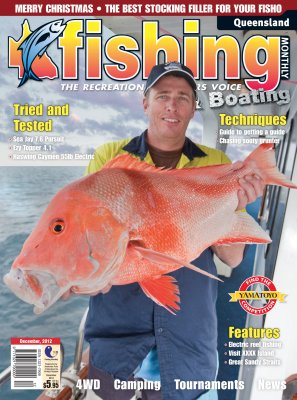Forgotten treasure – sooty grunter by Mark Ward
 When we think of snag dwelling battlers, images of barramundi, mangrove jack and big, blue-nosed bream come to mind but in the freshwater of Far North Queensland, the sooty grunter has managed to fly under the radar. Even in impoundments where these brutes can reach 4kg+, they seem to be largely forgotten about.
When we think of snag dwelling battlers, images of barramundi, mangrove jack and big, blue-nosed bream come to mind but in the freshwater of Far North Queensland, the sooty grunter has managed to fly under the radar. Even in impoundments where these brutes can reach 4kg+, they seem to be largely forgotten about.
That is until now. I'm about to blow the lid on one the best cover-ups in the piscatorial world. The sooty grunter, black bream or just plain old sooty, hangs in snags, loves lures, fights dirty and doesn't even taste too bad. All of the ingredients of a top class sportfish but without the reputation.
Sooties can be found all across North Queensland as well as NT and Northern WA. Their distribution in Queensland starts just north of Mackay however, the freshwater streams that are influenced by a distinct wet season seem to be the most productive. Sooties use the rising water levels of the wet season to begin their spawning and it is the big flowing rivers that seem to have the bigger populations of fish.
What is interesting about sooty grunter is the difference in the fish from one system to another. The crystal clear waters of the rivers right up near the tip of Queensland have very light coloured fish, almost yellow, while just a little south of that, rivers such as the Mitchell have a very dark, almost black population of sooties. The few that I have caught in the impoundments have all been a little different again, with most fish being grey with dark blotches over their bodies.
The major rivers of Cape York are my preferred locations for sooty grunter, purely due to their sheer numbers. We get days of well over 100 fish being common in some rivers. For size, impoundments, such as Eungella Dam an hour and a half out of Mackay, are where the monsters can be found.
Sooties are at home in many different environments. While they like to have some structure, they are very aggressive feeders and will move well away from a snag and out into open water to hunt down baitfish or smash a lure. Weed beds are also popular hunting grounds due to insects and prawns, and I have heard that they are prone to eating berries and figs.
I spoke to two old blokes at Tinaroo Dam west of Cairns a year or so ago and they were there chasing sooties under fig trees that overhang the dam. They were telling me that the sooties wait for the figs to fall off the tree and as a result, are attracted to the splash of bait being cast out into the area. I can't confirm this from my own experience but these guys seemed to know what they were talking about.
I also read that aquarium kept sooties need to be fed well otherwise they will eat all the vegetation in the tank, only after they have cleaned up all other forms of life.
I guess the huge appetite of these fish is why that are so aggressive with bait and lures. I was photographing a sooty a while back and dropped my soft plastic over the side of the boat, only a few inches below the surface of the water. While the photograph was being taken, another sooty came up and grabbed the dangling lure, almost ripping the rod straight over the side of the boat.
Sooties don't seem to be too fussy and will take any bait that is local to the area, as well as bread and cheese mixes. When bait fishing, keep rigs as light as possible with a running sinker and a 1/0-3/0 hook.
I target sooties on soft plastics during the day and surface lures early morning or late afternoon. Surface fishing can be amazing with sooties constantly slamming a lure until hooking up. Small cup-faced poppers or little surface lures that you can employ the walk-the-dog retrieve, such as the 8cm Zip N Ziggy, are perfect.
Prawn shaped soft plastics, such as Berkley Gulps or Atomic Prongs, seem to produce